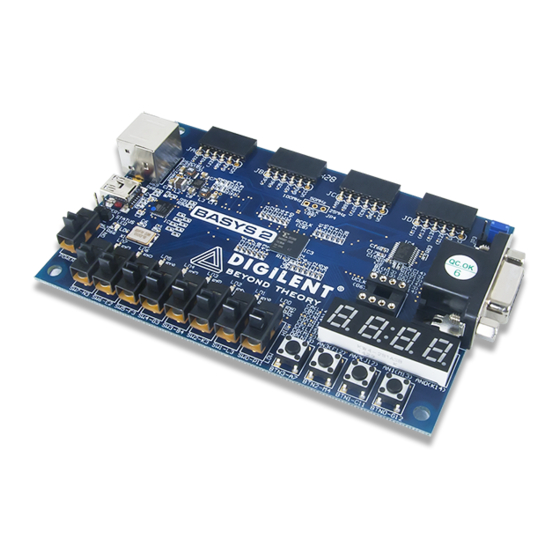Digilent Basys 2 Referentiehandleiding - Pagina 2
Blader online of download pdf Referentiehandleiding voor {categorie_naam} Digilent Basys 2. Digilent Basys 2 12 pagina's. Fpga board

Basys2™ FPGA Board Reference Manual
The Basys 2 board is designed to work with the free ISE WebPack CAD software from Xilinx. WebPack can be used
to define circuits using schematics or HDLs, to simulate and synthesize circuits, and to create programming files.
WebPack can be downloaded free of charge from www.xilinx.com/ise/.
The Basys 2 board ships with a built-in self-test/demo stored in its ROM that can be used to test all board features.
To run the test, set the Mode Jumper (see below) to ROM and apply board power. If the test is erased from the
ROM, it can be downloaded and reinstalled at any time. See
documentation, reference designs, and tutorials.
1
Board Power
The Basys 2 board is typically powered from a USB cable, but a battery
connector is also provided so that external supplies can be used. To use USB
power, simply attach the USB cable. To power the Basys 2 using a battery or
other external source, attach a 3.5V-5.5V battery pack (or other power
source) to the 2-pin, 100-mil spaced battery connector (three AA cells in
series make a good 4.5+/- volt supply). Voltages higher than 5.5V on either
power connector may cause permanent damage.
Input power is routed through the power switch (SW8) to the four 6-pin
expansion connectors and to a Linear Technology LTC3545 voltage
regulator. The LTC3545 produces the main 3.3V supply for the board, and it
also produces 2.5V and 1.2V supply voltages required by the FPGA. Total
board current is dependent on FPGA configuration, clock frequency, and
external connections. In test circuits with roughly 20K gates routed, a 50MHz clock source, and all LEDs
illuminated, about 100mA of current is drawn from the 1.2V supply, 50mA from the 2.5V supply, and 50mA from
the 3.3V supply. Required current will increase if larger circuits are configured in the FPGA, or if peripheral boards
are attached.
The Basys 2 board uses a four layer PCB, with the inner layers dedicated to VCC and GND planes. The FPGA and the
other ICs on the board have large complements of ceramic bypass capacitors placed as close as possible to each
VCC pin, resulting in a very clean, low-noise power supply.
2
Configuration
After power-on, the FPGA on the Basys 2 board must be configured before it can perform any useful functions.
During configuration, a "bit" file is transferred into memory cells within the FPGA to define the logical functions
and circuit interconnects. The free ISE/WebPack CAD software from Xilinx can be used to create bit files from
VHDL, Verilog, or schematic-based source files.
Digilent's PC-based program called Adept can be used to configure the FPGA with any suitable bit file stored on the
computer. Adept uses the USB cable to transfer a selected bit file from the PC to the FPGA (via the FPGA's JTAG
programming port). Adept can also program a bit file into an on-board non-volatile ROM called "Platform Flash".
Once programmed, the Platform Flash can automatically transfer a stored bit file to the FPGA at a subsequent
power-on or reset event if the Mode Jumper (JP3) is set to ROM. The FPGA will remain configured until it is reset
by a power-cycle event. The Platform Flash ROM will retain a bit file until it is reprogrammed, regardless of power-
cycle events.
Copyright Digilent, Inc. All rights reserved.
Other product and company names mentioned may be trademarks of their respective owners.
Basys 2
for the test project as well as further
Figure 2. Basys 2 power circuits.
Page 2 of 12
